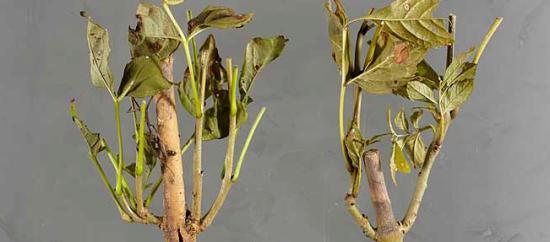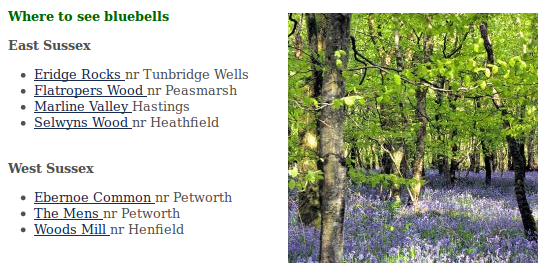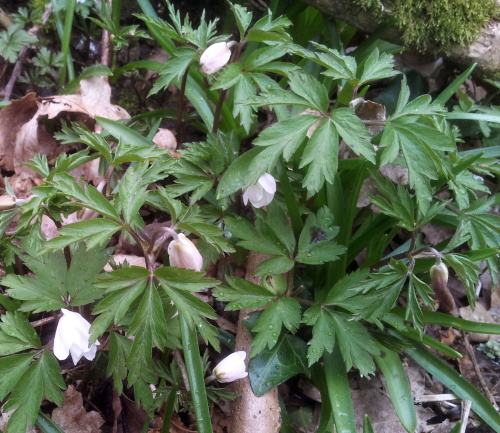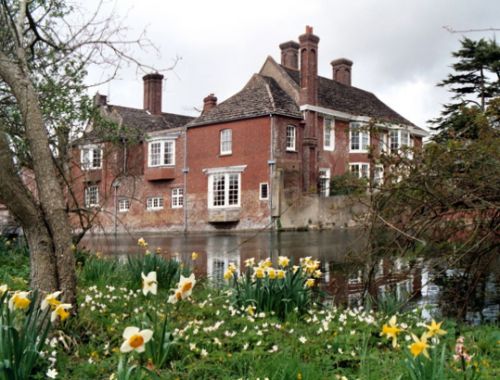Category Archives: Flora
Three acres and a cow

Three Sussex cattle have arrived at Woods Mill for the summer and are now receiving visitors in Little Meadow. Reserves Officer Steve Tillman explained why they are there:
Using cattle to control grass and vegetation growth is the ideal way to create the best habitat for a variety of wildlife. Ground nesting birds such as snipe will benefit from naturally grazed pasture as will a huge range of grasses and wild flowers, as well as barn owls who fly over the fields at dawn and dusk searching for field voles.
Woods Mill nature reserve is home to a wide variety of dragonflies including brown and southern hawkers, red and ruddy darters, black tailed skimmers and even the rare scarce chaser. Damselflies, easily spotted during the late spring and summer, include both the beautiful and the banded demoiselle and the powder blue azure damselflies. Grazing itself creates a variety of different length grasses while droppings from the cattle will attract the midges and flies that dragonflies and damselflies feed on.
Update, 5th June 2013: another eight have arrived.
Action in rural Sussex – Orchards
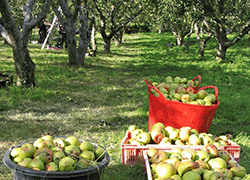 Action in rural Sussex and Brighton Permaculture Trust have now guided over 70 community groups and schools through the process of designing, planting and maintaining a small orchard (and occasionally , a larger orchard!). If you have ever thought that you would like to help the landscape of Sussex to be as fruitful as it once was, or to share with a new generation the pleasures of fresh orchard fruits and local apple varieties, just click on the link below. Community orchards offer a fantastic opportunity to grow an array of apples and other fruits you won’t find in the shops, are a haven for all kinds of wildlife, and are lovely places to enjoy, at all times of year.
Action in rural Sussex and Brighton Permaculture Trust have now guided over 70 community groups and schools through the process of designing, planting and maintaining a small orchard (and occasionally , a larger orchard!). If you have ever thought that you would like to help the landscape of Sussex to be as fruitful as it once was, or to share with a new generation the pleasures of fresh orchard fruits and local apple varieties, just click on the link below. Community orchards offer a fantastic opportunity to grow an array of apples and other fruits you won’t find in the shops, are a haven for all kinds of wildlife, and are lovely places to enjoy, at all times of year.
http://www.brightonpermaculture.org.uk/community-orchards
Please do get in touch to find out more or ask any questions. Email me on this address for all orchard enquiries:
anne-marie.bur@brightonpermaculture.org.uk
Anne-Marie Bur
Co-ordinator Local Produce
PLEASE NOTE NEW DIRECT LINE NUMBER!
Direct Line: 01273 407310 Mobile: 07849 233294
 Action in rural Sussex
Action in rural Sussex
Sussex House
212 High Street
Lewes
East Sussex
BN7 2NH
Tel: 01273 473422
Fax: 01273 483109
Action in rural Sussex is a registered charity, number 1035401
Nature Tots
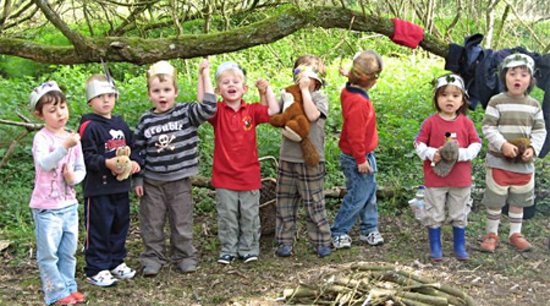
The Sussex Wildlife Trust has developed a Forest School programme specifically for pre-school age children (2-5 year olds) starting at Woods Mill Nature reserve. Nature Tots is a brand new programme focused around getting pre-school children engaged in wildlife and outdoor activity. More information here.
Tottington Wood Bluebell Strike
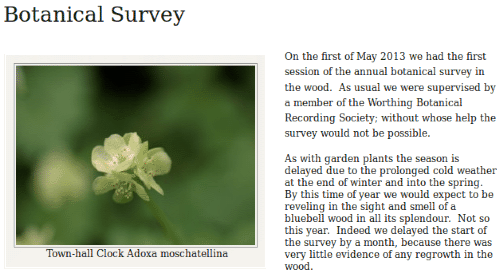
Read the rest of the report here.
Ian Phillips appointed to SDNPA

Today’s Midhurst and Petworth Observer reports:
Ian Phillips has been appointed as a new member of the South Downs National Park Authority (SDNPA) to replace Tom Tupper, who stepped down from the role last month. Ian Phillips, who lives in Farnham, is a chartered landscape architect and town planner with more than 25 years’ experience in urban and rural local government. His professional interests include green infrastructure, policy development, planning for trees and community engagement and he has spoken on these topics at national and international events. He serves on the Landscape Institute’s council and policy committee and is chairman of its appointments committee. He pursues a keen interest in trees as chairman of the Tree Advice Trust, as a contributor to relevant British Standards and as a member of the Trees and Design Action Group.
The View from Pippins, Spring 2013
In this unseasonably cold weather the trees and bushes on the Downs seem to be “oozing” rather than bursting into life! There are changes every day and there is a gorsebush bravely blooming halfway up to the top. Mind you, the old saying that when the gorse is out of bloom then kissing is out of fashion suggests that it’s generally blooming somewhere!!
Our garden aconites have come and gone and the primroses rehomed from my mother’s Kentish garden are brightening up the bank, mirroring those further up the bridlepath opposite “Downside”.
Wood anemones are flowering and wild garlic leaves are coming up…the latter delicious made into a pesto with walnuts (try kent cobnut oil or walnut oil) or used to wrap butter around a chicken breast: Yum!!
We have lambs at last! Two sets of twins, little black rams to Molly and a white girl and boy to Darcy with three more ewes to lamb, although two of those are not looking very pregnant!

Molly with James,her first born!
We are keeping the flock up by the house in this cold weather but they will be back to the Shepherd and Dog once they can cope without a shelter, and are big enough to escape the fox.
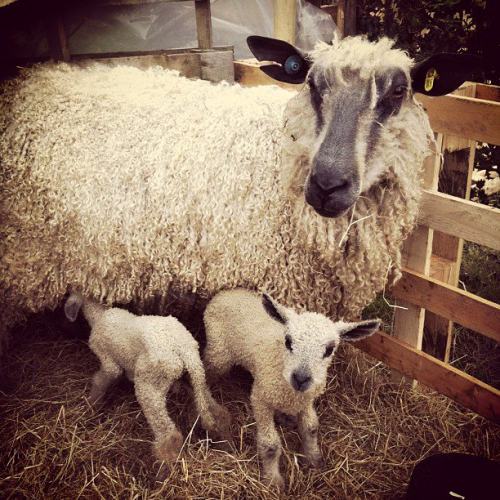
Darcy with twins Margot and Rudie
Schmallenberg
The threat of Schmallenberg virus is sadly still very much hanging over UK farmers this Spring, to compound the trials of those who are also losing lambs to the snowy weather. A report on the radio this morning asked us all to support them by buying English lamb as often as possible and I’m sure we don’t need too much encouragement.
A little background to this new disease .. It is named after the town in Germany where it was first identified (coincidentally twinned with Burgess Hill!) and is an “orthobunyavirus”, spread by midges similar to the Akabane virus found in the hotter parts of the world. Its epidemiology can therefore be cautiously predicted using that virus as a model, and it does seem that affected animals, primarily sheep and cattle, become immune in subsequent years and will give birth to normal offspring the following season. Sadly the lambs and calves born to vulnerable (i.e. non-immune) adults infected at the crucial stage of pregnancy (25-50 days for sheep, 70-120 days for cows) are born with abnormalities such as fixed and inflexible joints, a twisted neck or spine, domed skull or a short jaw, deformities usually incompatible with life, and very often needing a caesarean to deliver them. As you can imagine this plays havoc with the farmers profit margin.
We are keeping our fingers crossed that our little flock of Wensleydales will not be affected. It is hard to assess the local risk as a proportion of lambs are always still born for various reasons, and local farmers have only just started lambing. Let’s hope this freezing weather will have at least seen off the affected midge population – every cloud…..!
Pippins
Newtimber Place Gardens
Autumn Flower Arranging Competition
Won by Lady Nidgett for the third year running! A spectacular display combining bloodroot, deadly nightshade, black snakeroot, false hellebore, horse nettle, spurge and wolfsbane with wire and bits of straw.
Unfortunately, the Nidgett’s dog, “Rommel”, ate the exhibit before we were able to photograph it.

